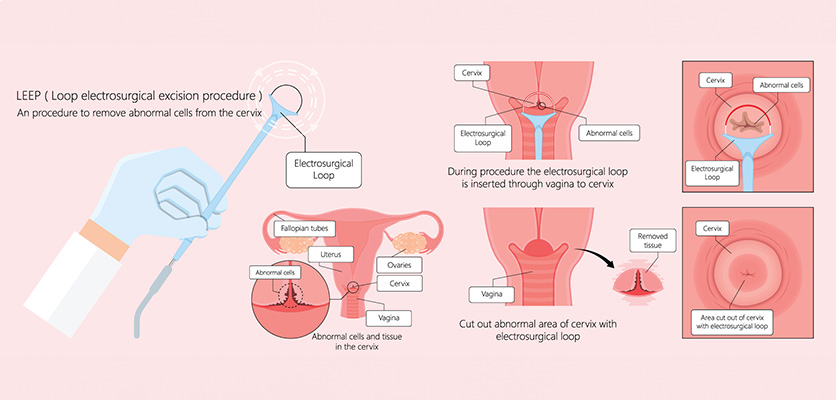03 January 2025
•3 minute read
The Diagnosis & Subsequent Care of Cervical Cancer
Cervical cancer may go undetected in its early stages, but its impact is far-reaching and potentially life-threatening. According to HPV Information Centre, cervical cancer ranks as the fourth most common cancer among women in Malaysia, with approximately 1,740 new cases and 991 deaths reported annually. It is also the most common cancer among Malaysian women between 15 and 44 years old. Globally, cervical cancer is the fourth most common cancer in women, according to the World Health Organisation (WHO), as there were an estimated 604,000 new cases and 342,000 deaths in 2020.
These alarming numbers stress the need for awareness campaigns to educate women about preventive measures and the importance of regular screenings. By raising awareness about cervical cancer risk factors, symptoms, and screening methods, women can be empowered to take proactive steps toward early detection and treatment, ultimately reducing the burden of this disease on them.
A closer look at cervical cancer diagnosis

Overview of loop electrosurgical excision procedure (LEEP). This procedure is commonly used to test and treat abnormal cell growth on the surface of the cervix. Click on the image for a larger and clearer version.
- Pelvic examination
This test is used to check for any unusual changes in the vulva, vagina, cervix, uterus, ovaries, and other nearby areas.
- Pap smear test
For this test, samples of cells are scraped from both the outer and inner surfaces of the cervix for testing.
- Human papillomavirus (HPV) typing test
HPV can be divided into two categories; high-risk and low-risk. High-risk HPV such as HPV16 and HPV18 are strains that are seen more often in people with cervical cancer. A positive result on the HPV test indicates the presence of high-risk HPV.
- Colposcopy
This test involves using a special instrument called a colposcope to magnify the cells of the cervix and vagina, operating much like a microscope. It gives the doctor a well-lit, magnified view of the tissues in the vagina and cervix, facilitating the process of taking accurate biopsies.
- Biopsy
A biopsy involves the extraction of a small tissue sample for microscopic examination, aiding in the definitive diagnosis process. It can be:
- Endocervical curettage (ECC): Checking an area inside of the cervix opening.
- Loop electrosurgical excision procedure (LEEP) or Large Loop Excision of Transformation Zone (LLETZ): Using an electrical current passed through a thin wire hook. The hook removes tissue for examination in the laboratory.
- Conization (cone biopsy): Removing a cone-shaped piece of tissue from the cervix.
Staging of cervical cancer
Once cervical cancer is diagnosed, the staging of the cancer is done. Staging is a way of determining the location of the cancer, the extent of the cancer, including whether it has spread and its impact on other parts of the body.
Cervical cancer ranges from stage one to stage four. Stage one is when the cancer has spread from the cervix lining into the deeper tissues but remains localized within the cervix without spreading to the other parts of the body. Conversely, stage four is when the cancer has spread to other parts of the body.
From diagnosis to recovery
The choice of treatment is determined by factors such as test results, cancer stage, patient’s age, and overall health, as well as patient’s plans for having children, if any.
The most common treatment for cervical cancer is surgery or a combination of chemotherapy and radiotherapy or both. Surgery is typically advised for women with a tumor localized in the cervix. The main type of surgery is a hysterectomy, which is an operation to remove the uterus and the cervix. Other organs of the reproductive system or the lymph glands on the side wall of the pelvis may also be removed during surgery.
A less common surgery is trachelectomy which involves the removal of part or all of the cervix alongside the upper part of the vagina. This option may be considered for young women diagnosed with early-stage cancer who wish to preserve the possibility of having children.
Other than that, chemotherapy uses drugs to kill cancer cells or to impede their growth. This treatment option can be considered if the cancer is advanced or has returned after treatment. Sometimes, chemotherapy is combined with radiation therapy, which is also known as chemoradiation.
Lastly, radiation therapy, also known as radiotherapy, utilizes X-rays to eliminate or impair cancer cells. It specifically targets the affected areas of the body where cancer is present or where cancer cells may have spread.
Vigilance beyond treatment
Follow-up care typically includes a review of clinical history and a physical examination, which involves a pelvic examination and a smear of the vagina. Additionally, a crucial aspect of follow-up care involves monitoring for recurrence.
Recurrent cancer is defined as the return of cancer post-treatment. It can return at the same place (local recurrence), nearby parts (regional recurrence), or in the other parts of the body (distant recurrence). In the event of recurrence, a new round of testing will be done to gather comprehensive insights before devising a new treatment plan.
Thriving through cancer

- Eating a healthy, well-balanced diet
Consuming a diverse range of nutritious foods is essential for supporting treatment and recovery. A balanced diet not only fuels the body for optimal functioning but also aids in tissue healing and mood regulation. Prioritizing fruits, vegetables, and minimally processed foods contributes to overall well-being and enhances energy levels.
- Exercising regularly
Regular exercise can improve recovery and reduce negative side effects such as fatigue. Exercising can also help in promoting overall fitness, boosting energy levels and spirits, improving the immune system, as well as improving emotional outlook.
- Quitting smoking
Quitting smoking is crucial as it significantly reduces the risk of various cancers and health complications. Moreover, it enhances the body’s ability to heal and boosts the immune system, aiding in cancer treatment and recovery.
- Taking actions to prevent infections
Cancer and its treatments suppress the body’s immune system. This can increase the risk of infection or increase the severity of common infections such as cold or flu. To decrease the risk of infection during cancer treatment, cancer patients need to practice proper hand hygiene, avoid crowded areas, and receive immunization against flu and pneumonia.
- Embracing complementary therapies
Complementary therapies like acupuncture, massage, meditation, and yoga can be incorporated alongside conventional treatments to enhance quality of life. It is crucial to recognize that while these therapies can provide valuable support, there is no evidence to suggest that they can treat or cure cancer.
- Seeking support
Receiving a cancer diagnosis is a profound and challenging life event. Confronting the uncertainty of a serious illness, managing anxiety, adapting to lifestyle changes, and grappling with the potential impact of the treatment can be overwhelming. Studies indicate that individuals who actively seek support during their cancer recovery tend to maintain a more stable emotional balance. Peer group support, such as that offered by organizations like the National Cancer Society Malaysia (reachable at 1-800-88-1000), can provide valuable healing benefits and assistance through turbulent times.
This article first appeared in HealthToday, 03 Jan 2025.
Share:
Was this article helpful?
03 January 2025
•3 minute read
The Diagnosis & Subsequent Care of Cervical Cancer
Articles and Video
Learn more about Obstetrics And Gynecology in Columbia Asia
Learn MoreShare:
Was this article helpful?
Health Packages
Elevate your health with tailored health packages at Columbia Asia Hospital. Take charge of your health journey today.

